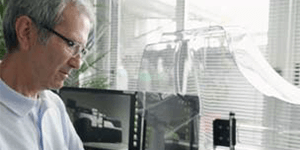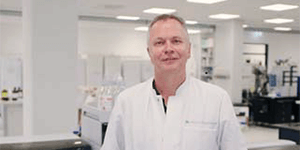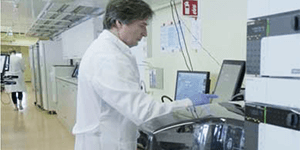“A main benefit for us is that we can use in-house methods from other LC-MS systems. For one method it’s an afternoon’s work – so it’s very easy to do.” Lars Kröner, Department Toxicology, Labor Dr. Wisplinghoff, Cologne, Germany.
First, what is CLAM-2000? In short, it is a fully automated sample preparation module for LC-MS that is based on Shimadzu’s time-tested blood coagulation technology. But in reality, it is so much more. Why? Because CLAM-2000 essentially automates the entire LC-MS/MS workflow in a way that few in the clinical analysis field expected. And it heralds a big shift in how LC-MS is likely to continue penetrating the clinical space. I consider myself lucky to have seen the impact of the CLAM-2000 first hand. I joined Shimadzu during its development, and had the opportunity to spend time with the prototype system installed in Paolo Brambilla’s Clinical Chemistry Laboratory at Desio Hospital in Milan. It was an exciting and rewarding time – I acted as the interface between clinical expectations and development of the solution, and it was great to see both sides of the story so closely.
Judging potential impact
Even in its prototype phase, it was clear that many of the features (and the subsequent benefits) were very much appreciated by the users of the system. For example, when we launched the software at Desio for the first time, the staff noted how user friendly it was, and said, “It’s even easy to imagine how people with no training in chromatography or mass spectrometry would be able to operate CLAM.” From Shimadzu’s perspective, it was great to be able to optimize minor aspects of the system (for example, sample loading times and reagent consumption) in the real-life environment for which it is designed. That was back in 2015, and it gave us complete confidence when we commercially launched the CLAM-2000 in 2016 – the same year it featured in The Analytical Science Innovation Awards (TASIAs). The TASIA judges understood our objective, saying, “Sample preparation is the biggest challenge in most analytical methods. Automation is key to addressing this challenge – especially for biological samples [...] The CLAM-2000 completely automates sample preparation for clinical samples; this could help prevent user error in labs where accurate analysis is of the utmost importance”Automated... but flexible
Despite the “push-button” simplicity and “walk-away” reliability that can come with automated solutions, we understand that we must cater to users of different competency levels – from technicians to clinical laboratory managers. And though the CLAM-2000 LC-MS/MS system works well with commercial kits, many users want the flexibility that comes with a traditional LC-MS/MS system; they want to create new methods or transfer current methods over to the automated system. The need for flexibility comes across very strongly when talking with potential users – and current users, for example, the researchers in the clinical lab at Desio. The CLAM-2000 (unusually) combines simplicity for less experienced users with the complete flexibility or ‘openness’ that an experienced chromatographer or mass spectrometrist would expect from any other LC-MS/MS system. And that’s the real – hopefully not hidden – beauty of CLAM!“Curiouser and curiouser!”
Ever since the launch, the clinical community has been very curious about the CLAM-2000 – especially because it was the first fully-integrated LC-MS/MS sample preparation system of its kind. Initial assumptions that it is a “black box” with limited applications are quickly dispelled with the long list of potential analytical applications and the options for further customization and method development, as highlighted above. But once methods are chosen or developed and approved, the CLAM-2000 system can be operated by technicians who are more familiar with immunoassays, freeing up (sometimes limited) LC-MS/MS expertise for less routine tasks. After all, once the method is locked and loaded, it’s a simple case of placing blood collection tubes, reagents, and specialized pretreatment vials into the CLAM-2000, which then performs all processes automatically, right through to reporting of results. Notably, different sample vials can be subjected to different methods within the run. In therapeutic drug monitoring (TDM), for example, you can assign an analyte to each vial, and the instrument automatically selects the correct sample prep and analytical method. Not only does it eliminate tedious sample preparation steps (which also frees up technician time) – it also reduces the risk of operator error, increasing reproducibility. In essence, it means you can trust the system to run analyses for hours on end. Moreover, the system has many ‘check-points’ at the various analytical steps (sample preparation, calibration and so on) so if something does go wrong – a loading error, for example – it’s obvious what went wrong and with which sample.Four researchers share their experiences with CLAM-2000




“It’s possible to walk away from the instrument and allow it to perform hours and hours of work without the intervention of our technicians. I was very impressed with the possibilities the CLAM gave in our laboratory.” Paolo Brambilla, Clinical Laboratories’ Director, Milano-Bicocca University at Desio Hospital, Milan, Italy
“A main benefit for us is that we can use in-house methods from other LC-MS systems. For one method it’s an afternoon’s work – so it’s very easy to do.” Lars Kröner, Department Toxicology, Labor Dr. Wisplinghoff, Cologne, Germany.
“The goal is to implement 24/7 routine analysis of drugs with the CLAM system.” Frank Streit, Head of Clinical Research, University Medical Center Göttingen, Germany
“We have compared the old liquid-liquid extraction and solid-phase extraction procedures with the [CLAM-2000] and we gain a lot of time in the preparation of a series of tubes.” Franck Saint-Marcoux, Department of Pharmacology, Toxicology, and Pharmacovigilance, University Hospital of Limoges, France

